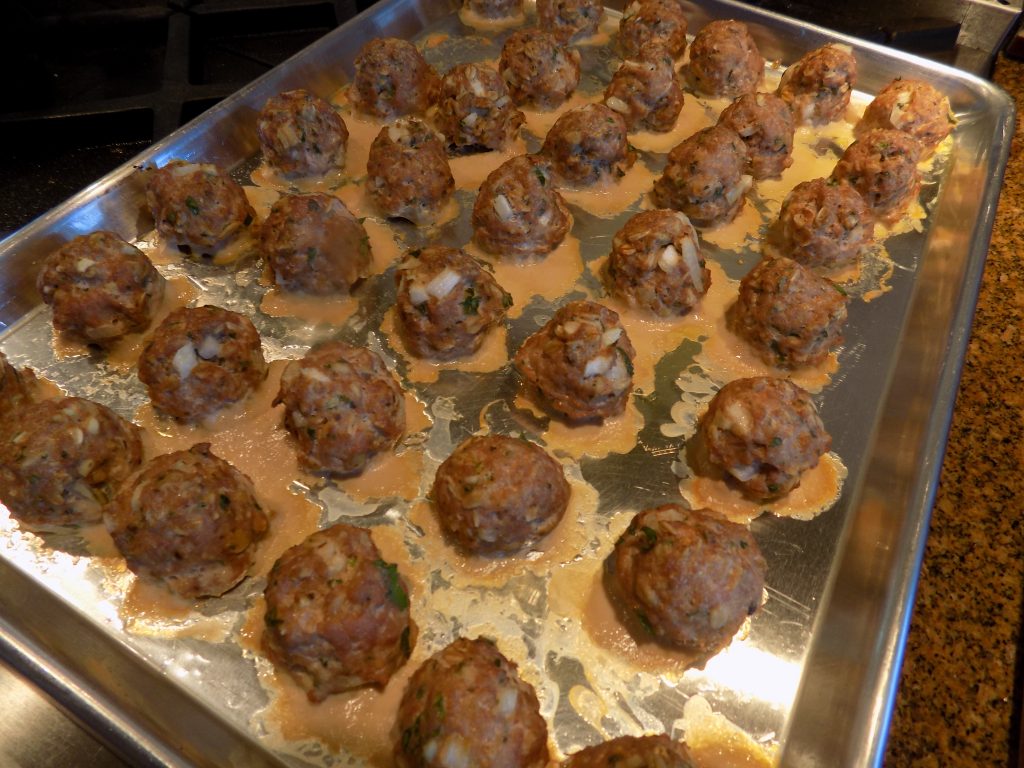
This is a low fat recipe. Both the meatballs and the sauce are basically good for you. Now what you serve them on can be a different story. But I’ll get to that later. For now let’s just concern ourselves with the meatballs and sauce.
First the meatballs. What can I say except I probably have never met a meatball I didn’t like. OK, that’s not true. Let me re-state that. I have never met a homemade meatball I didn’t like. I have unfortunately met quite a few mass produced meatballs that, well frankly, I wouldn’t give to a dog. (And I’m not crazy about dogs.)
But homemade meatballs. Ahhhhh. They are routinely delightful. And these ground turkey meatballs are no exception. Thanks to the Culinary Hill web site for this terrific meatball recipe.
Now on to the marinara sauce. This is my “go to”, never fails me, always loved by one and all, never to be changed, simple, always in style, Italian to the core, decades old recipe for marinara sauce. (If that description doesn’t win you over, I haven’t a ghost of a chance of converting you to my thinking, so leave this post immediately.)
But if you are still with me, this is the sauce for you.
Now onto what to serve these delightful meatballs and this incredible sauce on. (And yes I know not to ever, ever end a sentence with a dangling participle. But shucks, I only minored in English in college, so cut me some slack!) Anyway…..
If you are truly concerned about healthy eating, you can always serve these meatballs and this sauce on spaghetti squash, quinoa, black beans, or shirataki noodles. (Haven’t tasted shirataki noodles myself, but what I have read scares the heck out of me, so you will have to venture into this uncharted territory with someone else as your guide.) But if you are like me, and want to stick to the real reason meatballs and sauce were invented in the first place, let’s talk pasta. (And yes I know, pasta gets a lot of bad press.) But from everything I’ve read and heard, foods we eat affect our blood sugar. And since pasta is a high carbohydrate food, diabetics particularly need to watch portion sizes so their blood sugar levels don’t spike.
But pasta itself is a lower glycemic index food. And eating food with a lower glycemic index can help keep blood sugars more stable than eating foods on the higher glycemic index scale. So here’s the good news. Cooking pasta al dente, which I always recommend, helps keep blood sugar in better control. Plus, when pasta is cooked al dente, it remains firmer for better texture, mouth feel, and taste. So for those of you who are especially concerned, but don’t want to entirely give up pasta, always cook pasta al dente, if not molto al dente, and reduce the quantity you normally consume.
For more information, go on line. There is more information about pasta being OK (within limits) than you can ever hope to read. Also there are some great articles on how to cook pasta al dente. Actually molto al dente is best when you are adding the pasta to a sauce. I recommend an article written by Alex Delany for Bon Appétit magazine – December 14, 2017. Good information.
I hope you enjoy these recipes. Happy eating everyone.
Meatballs Recipe:
½ c. finely minced onion
3 garlic cloves, finely minced
1/3 c. minced fresh parsley
2 lg. eggs
2 tsp. Worcestershire sauce
½ tsp. dried basil
½ tsp. dried oregano
1 tsp. seasoned salt
freshly ground black pepper
1 c. rolled oats
2 lbs. ground turkey or chicken (93% lean)
extra virgin olive oil
In a large bowl, combine the onion, garlic, parsley, eggs, Worcestershire sauce, basil, oregano, seasoned salt, and pepper.
Stir in the oats and ground turkey. Mix well, but don’t over work the meat. Using a small ice cream scoop, plop meatballs on a lightly greased rimmed baking sheet. Using a pastry brush, gently slather each meatball with olive oil.
Bake the meatballs in a pre-heated 400 degree oven until browned and cooked through, about 15 to 20 minutes (an internal thermometer should read 155 degrees). Remove from oven and use immediately, or allow to cool and refrigerate or freeze.
To freeze the meatballs:
Arrange in a single layer on a baking sheet, not touching. Freeze until solid, about 1 hour, then transfer to a freezer-safe container and store up to 1 month.
Marinara Sauce Recipe:
2 T. extra-virgin olive oil
½ c. chopped onion
2 cloves garlic, chopped
1 (28-oz.) can chopped or diced tomatoes (Italian tomatoes preferably)
1 bay leaf
pinch crushed red pepper flakes
1 tsp. dried oregano (I use Mexican oregano)
½ tsp. kosher salt
freshly ground black pepper
3 T. chopped fresh basil leaves
1-2 T. butter, opt.
In a large covered sauce pan, heat the oil over medium high heat. Add the onion and sauté until soft and translucent, about 6 minutes. Stir in the garlic and cook for an additional minute. Add the tomatoes, bay leaf, red pepper flakes, oregano, salt, and pepper. Stir to combine ingredients. Bring to a boil, reduce heat, cover, and simmer for about 30 minutes. (Take the lid off part way if the sauce is too thin or allow to gently burble away until the sauce reaches your desired thickness.) Remove from heat, discard bay leaf, add the basil, and adjust seasoning. If the sauce tastes acidic, add butter 1 tablespoon at a time to round out the flavor.
